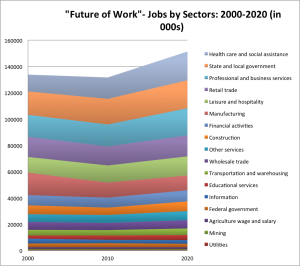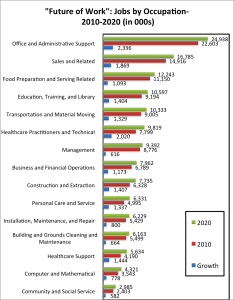 This Thursday, December 10, the U.S. Department of Labor (DOL) is hosting a forum on the “Future of Work”. It is widely promoting this forum as an all-day session bringing together business leaders, academics, workers and advocates to identify the “remarkable technological, economic and cultural changes” of recent years and their “profound impact throughout the economy and the workforce”.
This Thursday, December 10, the U.S. Department of Labor (DOL) is hosting a forum on the “Future of Work”. It is widely promoting this forum as an all-day session bringing together business leaders, academics, workers and advocates to identify the “remarkable technological, economic and cultural changes” of recent years and their “profound impact throughout the economy and the workforce”.
Since I started in the job training world in 1979, similar forums on the future of work have been held on a regular basis. They have been hosted by the state or federal governments or private foundations. They have spoken in similar elevated terms about remarkable changes and profound impacts.
In nearly all cases over the years, the projections about the future of work have turned out to be wrong. Technology has destroyed jobs, as projected, but other jobs have been created, and in very few cases have the jobs created been envisioned in the years before. In the 1980s, none of the conferences and books on the future of work envisioned the jobs created with the internet or the internet economy.
Further, the projections in the 1980s and 1990s about sectors such as manufacturing or retail trade disappearing have proved to be wrong, as have projections about the disappearance of low-tech jobs such as office clerks or home health aides or food preparation workers. In many ways, what is striking since 1979 has been the stability in terms of sectors and occupations
The chart above (click to enlarge), developed with economist Richard Holden, shows the number of jobs by sector in 2000 and the numbers projected by the Bureau of Labor Statistics (BLS) for 2010. What stands out is the continued diversity among these 17 industry sectors, including manufacturing and retail trade. Similarly, the chart below (click to enlarge), of BLS occupational projections shows the continued diversity of occupations.
So, we need to be wary of too grand claims about how technology and robots will be eliminating us all; or how there will not be enough jobs to go around. The past four decades suggest that we do not see clearly more than a short time out in the labor market.
At the same time, there is no question that the structure of employment is evolving. The great majority of workers today as in 1979 are in an employer-employee relation. However, the role of contingent employment is rapidly increasing and likely will continue to increase—and we’ll learn more on this with DOL resuming its Alternative Work Arrangements research. Further, the part-time workforce grew sharply during the Great Recession, and continues above pre-Great Recession levels; and the job search obstacles for workers over fifty are growing as are the challenges for workers with developmental differences.
The DOL “Future of Work” forum can have value as it keep projections modest and as it relates the evolving structures noted above and others to the DOL mission of fuller employment. What is the relation between DOL’s workforce policies and the rise of contingent and part time work? What advice can be offered for the local Workforce Development Board staff in placing “older workers”? Or, more broadly, as Michael Krisman, the former EDD deputy director, used to ask of any workforce discussion that threatened to become theoretical, “What does this mean for the job seeker in Glendale?”


